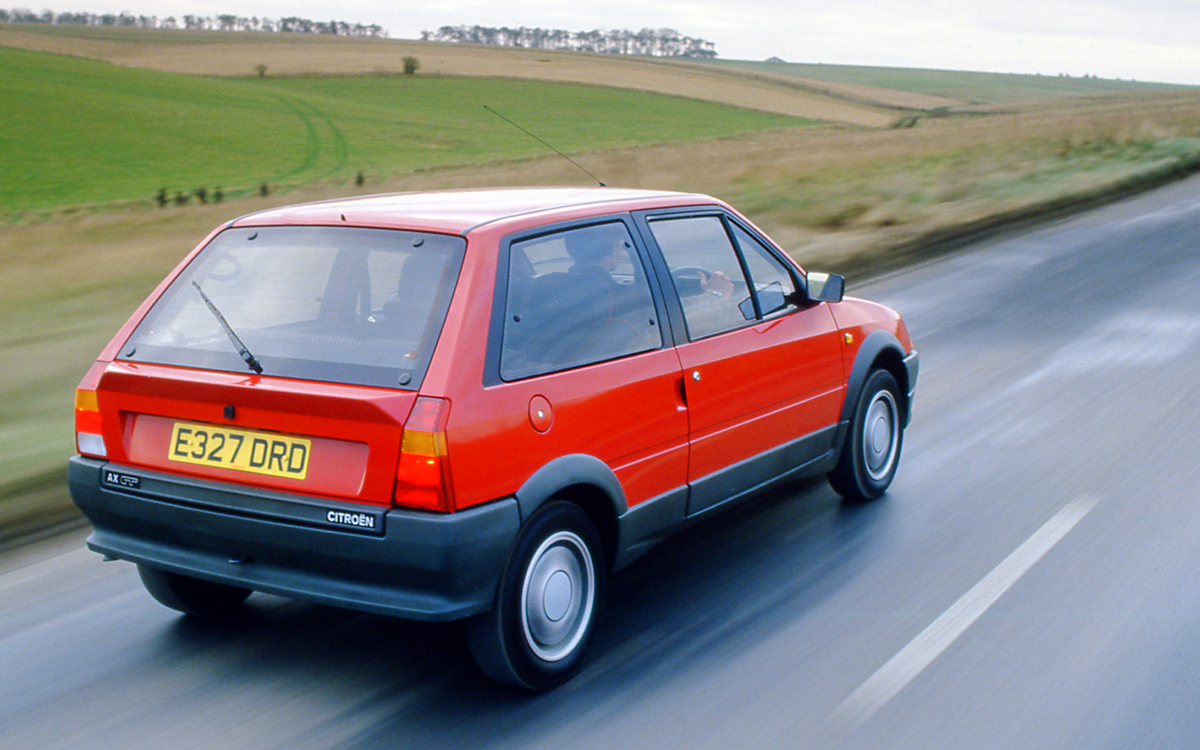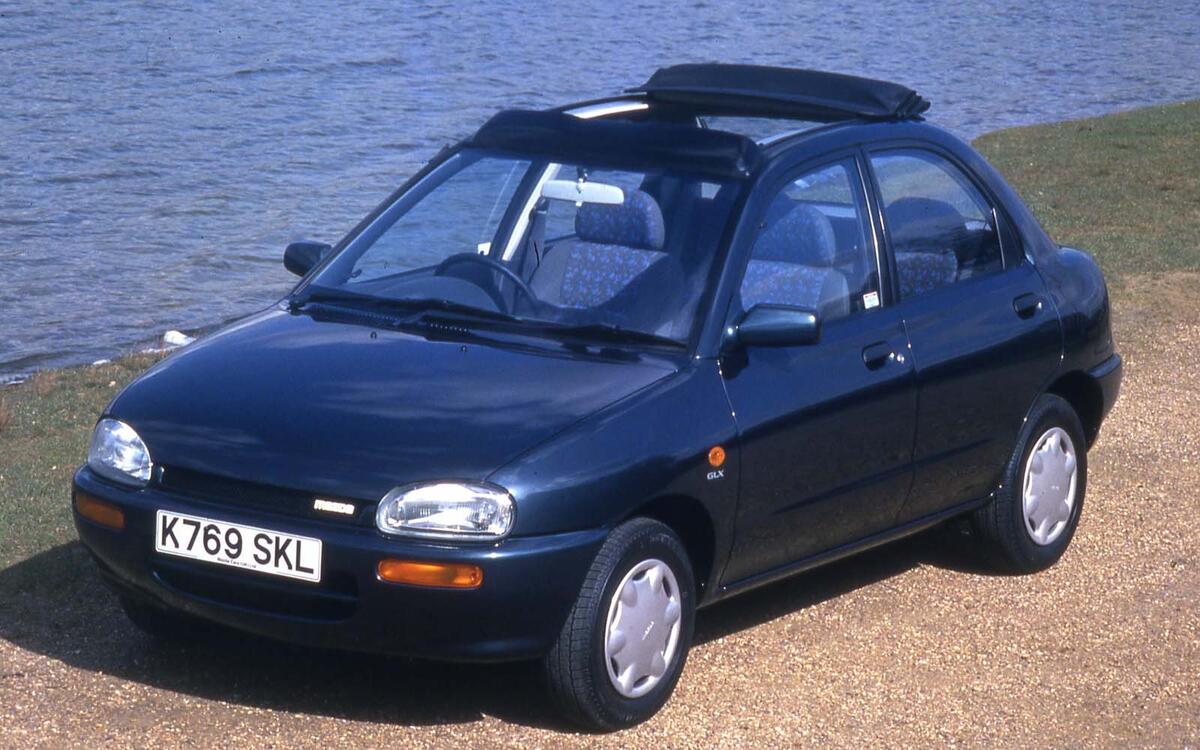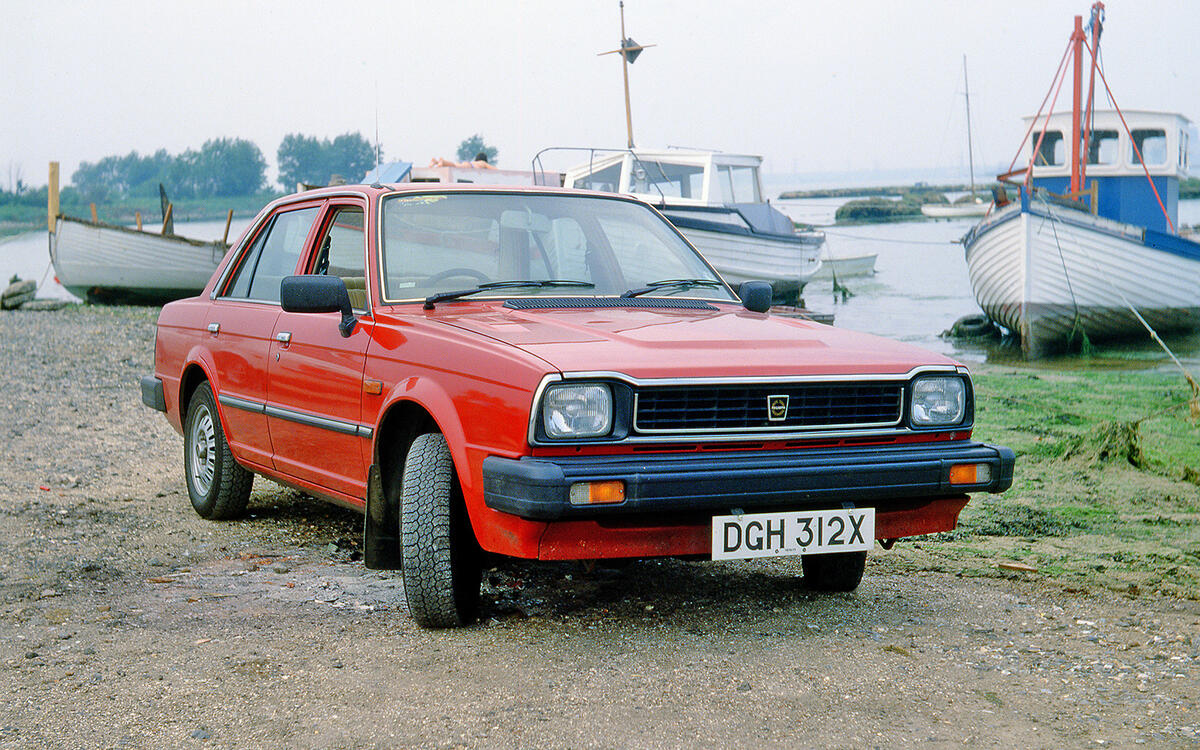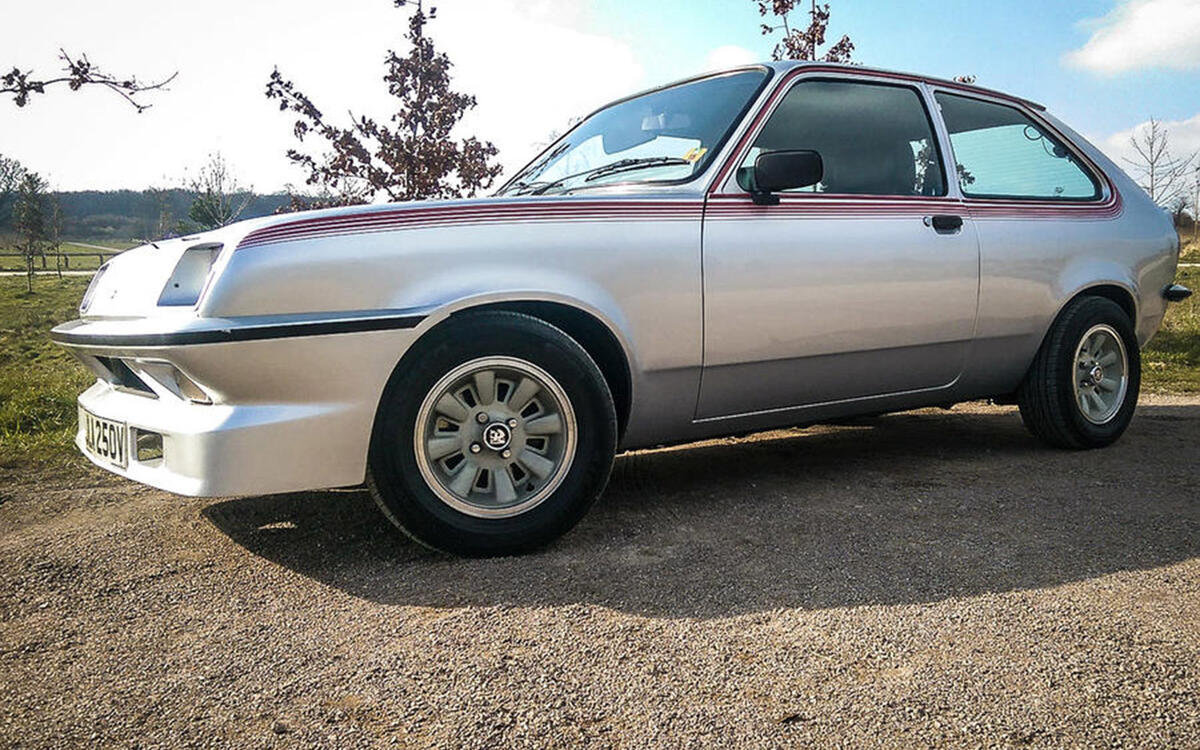 Slide of
Slide of
Disappearing act.
According to the latest DVLA data, there are around 600 examples of the McLaren 720S taxed in Britain. Lamborghini Urus? That’d be over 1400. The number of Ferrari F430 variants is close to 1000. In other words, you’ve got more chance of seeing these exotic cars than many popular cars of the 1970s, ’80s and ’90s.
We’ve selected 40 classics you don’t see anymore, although it must be stressed that the DVLA data regarding surviving old cars is sometimes unreliable. Use these figures, which are based on cars with a tax ‘disc’, as a rough guide. We reference SORN numbers where relevant.
 Slide of
Slide of
Austin Allegro: 24 examples left on the road
This survival rate is poor, even for a much-maligned car like the Austin Allegro. This number includes the luxo Vanden Plas edition, which came complete with regal grille and delusions of grandeur. There are plenty of Allegros listed as SORN though, so all isn’t lost.
 Slide of
Slide of
Austin/MG/Rover Maestro: 300
The Maestro was BL’s replacement for the Allegro, but the fact that it sold in fewer numbers than its predecessor is a clue as to why so few are left. Of all the variants, the rapid MG version is the most coveted, and the survival rate reflects this; 47 MG Maestros are still on the road, including 11 Turbos.
 Slide of
Slide of
Austin Maxi: 12
The Austin Maxi is an example of the British car industry snatching defeat from the jaws of victory. A modern, spacious front-wheel-drive hatchback when the market was wedded to antiquated rear-wheel-drive saloons, it should have been a world beater. BL quality ensured that it wasn’t.
 Slide of
Slide of
Austin/MG Metro: 395
‘A British car to the beat the world’ was the promise, and the Austin miniMetro was good enough to live up to the hype. A brilliant PR campaign saw the nation swept along on a wave of patriotism, while an association with Lady Di did the little Metro no harm. Around 1.5 million were built before the revised Rover Metro arrived in 1991.
 Slide of
Slide of
Austin/MG/Rover Montego: 55
In isolation, the Montego was a good car. Unfortunately, rival manufacturers were building better alternatives, so not even the Montego Turbo, billed as ‘the quickest MG production of all time’ could prevent terminal decline as soon as production stopped in 1994.
 Slide of
Slide of
Chrysler/Hillman/Talbot Avenger: 59
Launched in 1970, the Hillman Avenger was the first Rootes Group car to be developed under the control of Chrysler. Indeed, it became the Chrysler Avenger as part of the 1976 facelift, before bowing out as a Talbot following the collapse of Chrysler Europe. A rare and interesting alternative to the Ford Escort and Cortina.
 Slide of
Slide of
Citroën AX: 326
Production of the Citroën AX totalled 2.5 million from 1986 to 1999, so it’s surprising to see so few left in Britain. Aggressive sales tactics and keen pricing meant that the AX was a common sight on Britain’s roads, but you’ll be lucky to spot one today. We suspect the Saxo is facing a similar period of decline.
 Slide of
Slide of
Citroën BX: 242
Another big seller for Citroën, with production totalling 2.3 million from 1982 to 1994. Citroën referenced Marcello Gandini in its advertising by asking: ‘How does the Lamborghini designer get to the Lamborghini?’. Of greater relevance was Citroën’s entry into the lucrative fleet sector, made possible by the ultra-frugal BX diesel.
 Slide of
Slide of
Citroën GS/GSA: 51
A deserved winner of the 1971 European Car of the Year award, the Citroën GS was one of the most technologically advanced cars of the 1970s. A remarkable alternative to mediocre cars like the Morris Marina, its usefulness was extended with the arrival of the GSA hatchback. Production totalled 1.9 million.
 Slide of
Slide of
Datsun/Nissan Bluebird: 244
The Bluebird’s strength was its all-round competency. It shined in no particular department, but it was perfect for the nation’s fleet managers and cab operators who loved its reliability, comfort and fuel economy. It was also the first car to be built at Nissan’s plant in Tyne and Wear.
 Slide of
Slide of
Datsun/Nissan 100A/Cherry: 51
One of the first superminis, the Datsun Cherry (100A in the UK) was also one of the first Japanese cars to arrive on these shores. Mechanical reliability were the watchwords of Japanese cars of this era; these cars started in the morning, while British and European vehicles faltered. Rust was their undoing.
 Slide of
Slide of
Fiat 126: 232
Like so many of the cars on this list, the Fiat 126 entered a period of near-terminal decline in the 1990s, when prices hit rock bottom and rust claimed many survivors. It was popular in the 1970s, not least because it was cheaper than the most basic Mini. Though never as iconic as the Nuova 500, the 126 enjoys a cult following, particularly in Europe.
 Slide of
Slide of
Fiat Uno: 144
It’s not as pretty as the Peugeot 205, but the Fiat Uno’s role in shaping the modern supermini is no less significant. It also won the European Car of the Year award in 1984, knocking the 205 into second place. The Uno Turbo is the one we covet, 24 of which survive, but the opportunity to see any remaining Uno would be a good thing. The car's name derives from the fact that it had only a single windscreen wiper.
 Slide of
Slide of
Ford Cortina: 698
That looks like a pretty good survival rate, until you remember that some 2.6 million Ford Cortinas were sold in Britain. For years, the Cortina was the family and company car to beat – often imitated, but rarely beaten. The last Cortina was built in 1982, but some remained unsold until 1987. There are a surprising amount still on the road - and a full 288 of them are the desirable and valuable Lotus Cortina variants.
 Slide of
Slide of
Ford Orion: 311
Fans of saloon cars with rear wipers will appreciate the Mk3 Ford Orion. Though less useful than a wiper on a hatchback or estate, a rear wiper can be handy when reversing in the rain. These are a couple of sentences you never thought you’d read in an Autocar story.
 Slide of
Slide of
Ford Probe: 263
Ford shifted a disappointing 15,000 Probes in the UK before pulling the plug in 1997, a long way short of the 20,000 annual target. It shared a platform with the Mazda MX-6 and was built in America, but the Probe failed to become the spiritual successor to the Capri. A shame because it looked good and was great to drive.
 Slide of
Slide of
Ford Sierra/Sapphire: 2446
We take it for granted today, but the Ford Sierra looked otherworldly when it touched down in 1982. Ford had the tough ask of convincing Cortina owners to jump into the radical new ‘jelly mould’ family car, yet despite early struggles, sales soon took off. Performance versions and success on the track played a part in its eventual rise to greatness.
 Slide of
Slide of
FSO: 19
Fabryka Samochodów Osobowych, sensibly known as FSO, was a former Polish car and parts manufacturer established in 1948. It started building cars under the Polski Fiat brand in 1965, with the 125p-based and Giugiaro-designed Polonez arriving in 1978.
 Slide of
Slide of
Hyundai Pony: 25
This was Hyundai’s first mass-produced and exported car, and therefore the first car the company sold in the UK. Hyundai drafted in former Austin-Morris MD George Turnbull to help with development, Giorgetto Giugiaro for design, and used Mitsubishi and Ford Cortina parts to create the Pony. It was simple but effective, and the start of South Korean sales in the UK.
 Slide of
Slide of
Kia Pride: 19
From Hyundai’s first UK model we turn to sibling Kia’s genesis on these shores. The Pride was based on the old Mazda 121, and while these were the days before the seven-year warranty, the little car undercut the Ford Fiesta and Vauxhall Corsa to help Kia secure a foothold in the market.
 Slide of
Slide of
Lada 1200/1300/1500/1600 and Riva: 64
The success of the VAZ-2101 far outweighed that of its donor car, the Fiat 124, even if the Italian saloon had won the European Car of the Year award in 1967. A common sight in the 1970s, the ‘Zhiguli’ was sold here as the Lada 1200, 1300, 1500 and 1600, before a reskin created the Riva. UK sales ceased in 1997.
 Slide of
Slide of
Mazda 121: 66
The Mazda 121 (DA) arrived here in 1987, but despite its roots as the Ford Festiva, it’s the 121 (DB) that’s the most interesting model. Sold as the Autozam Revue in its home market, the 121 was notable for its saloon body and canvas sunroof. The next 121 was little more than a rebadged Ford Fiesta.
 Slide of
Slide of
Morris Ital: 56
Take the commercial variant out of the question and the Ital was the last Morris car to be sold. As the styling suggests, it was a reheated Morris Marina for the 1980s, a car that was already looking seriously outdated. The Austin Montego couldn’t come soon enough.
 Slide of
Slide of
Morris Marina: 405
It’s easy to dismiss the Morris Marina – so many people have written it off as Britain’s worst car of the 1970s – but it’s worth remembering that it sold a million. BL was caught off-guard by Ford’s model restructuring, which meant the Marina got lost between the Escort and Cortina. It improved with age, but so did the competition.
 Slide of
Slide of
Opel Manta: 226
The rear-wheel-drive Manta was Opel’s answer to the Ford Capri. Both the Manta A and B used a humble platform, in this case the Opel Ascona, and treated it to a svelte two-door coupé body. The B evolved into the Manta GT/E, which remained on sale until 1988. It was succeeded by the front- and four-wheel-drive Calibra.
 Slide of
Slide of
Opel/Vauxhall Senator: 72
Traffic cops loved the big, powerful, spacious and comfortable Vauxhall Senator, with the 200bhp 3.0-litre 24-valve version quick enough to keep up with most hot hatches and performance coupés. The imposing front grille wasn’t something you wanted to see in your rear-view mirror.
 Slide of
Slide of
Peugeot 309: 295
The UK-designed 309 was destined to be called the Talbot Arizona until Peugeot made a late decision to bring it under its own wing. Examples still appear on sites like Facebook Marketplace and Gumtree, but only the GTI models are truly desirable. Indeed, the 309 GTI is every bit as good as the 205 GTI.
 Slide of
Slide of
Peugeot 405: 324
We could have filled this slideshow with Citroën, Peugeot and Renault cars from the 1970s, 1980s and 1990s. Many appear to be on borrowed time, even the Peugeot 405, which was a popular choice in the fleet sector. It bucked the trend by blending sharp handling with excellent ride comfort.
 Slide of
Slide of
Renault 4: 284
Launched in 1961, the Renault 4 took on the Citroën 2CV and won. Its hatchback-style body made it truly versatile, while simple engineering meant it was easy to maintain. The dependable 4 was perfect for France’s unmade rural roads, but UK examples are worryingly thin on the ground.
 Slide of
Slide of
Renault Fuego: 21
Renault called it ‘Le Plip’, and it meant that the Fuego became the first production car to feature remote central locking. ‘Dashing to your new Fuego on a rainy day, you press a button on the tiny gadget attached to your keyring. Instantly, there’s a reassuring click as both doors unlock,’ said the advert. Different times.
 Slide of
Slide of
Rover 800: 298
Sitting between the SD1 and 75 in Rover’s big car history, the 800 series always felt like a nearly car. Launched in 1986, the 800 came of age in 1988 with the arrival of the Honda 2.7-litre V6 engine, a car we described as “a real performance saloon”. With a great deal of foresight, we also said that Austin Rover “needs to look hard at its quality control”.
 Slide of
Slide of
Seat Marbella: 15
Of the 770,000 or so Seat Marbellas produced between 1986 and 1998, around 10,000 were sold in the UK. Obviously based on the Fiat Panda, the Marbella had to make do with the old Fiat 850 engine and leaf springs, but it’s a quirky classic, if you fancy rekindling memories of a cheap package holiday in Spain.
 Slide of
Slide of
Skoda Favorit: 66
Squabbles between Skoda and Bertone meant that the birth of the Favorit was delayed until 1987, five years after the design house was commissioned to work on the car. The first cars arrived here in 1989, two years before VW took the reins and began making improvements. The Felicia is essentially a heavily facelifted Favorit.
 Slide of
Slide of
Triumph Acclaim: 124
Some would argue that the last Triumph wasn’t a real Triumph. There’s some truth in that argument, because the Acclaim was essentially a rebadged Honda Ballade - a Civic with a boot - built in Britain. It was actually a very good car, although there wasn’t enough space for families and rust would be the undoing of many examples. Still, the Honda underpinnings meant that reliability wasn’t an issue.
 Slide of
Slide of
Vauxhall Belmont / Astra Belmont: 35
In CD trim (not pictured), the Astra Belmont was Vauxhall’s answer to the Ford Orion Ghia 1.6. ‘The new Astra Belmont CD. Rather more gear than the Ghia,’ was the headline, as Vauxhall promoted the luxury appointments of the three-box Astra. It even referenced Jaguar and Daimler in its ad. Bold stuff.
 Slide of
Slide of
Vauxhall Cavalier: 1248
It wasn’t that long ago when you’d almost certainly see a Vauxhall Cavalier on the way to the work. Most likely a Mk3, the Cavalier was a common sight on Britain’s roads, but you’re unlikely to see a Mk1 or Mk2 beyond a classic car show. Come to think of it, when was the last time you saw a Mk1 Vectra?
 Slide of
Slide of
Vauxhall Chevette: 333
Although most fondly remembered in HS form (pictured), the standard Vauxhall Chevette provided cheap and cheerful family transport from 1975 until 1984. It shared a lot in common with the Opel Kadett, but was set apart from its German cousin by the familiar Wayne Cherry styling. Some classic rear-wheel-drive fun is available, if you can find one.
 Slide of
Slide of
Vauxhall Nova: 826
A generation of Autocar readers will have fond memories of the Vauxhall Nova. Maybe it was your first car, and you remember sticking a pair of tea trays under the rear wheels for some sideways action. Once a familiar sight, there are thought to be fewer than 1000 Novas on the road, with many more listed as SORN.
 Slide of
Slide of
Volkswagen Vento: 88
You might have forgotten about the VW Vento, which was sold as the more familiar Jetta in some parts of the world. That’s the thing about three-boxes Golfs: they struggle to sell in a nation of hatchback worshippers. We can see the Bora going the same way. Gone with the wind, perhaps?
 Slide of
Slide of
Volvo 480: 167
We were tempted to end with the 340/360 or 440/460 range of cars, but our final berth is filled with some pop-up headlights. Volvo’s first front-wheel-drive car and the only one to feature pop-up lights – was built in the Netherlands and was powered by Renault engines. Not enough of them survive.
Access control:
Open




















































































